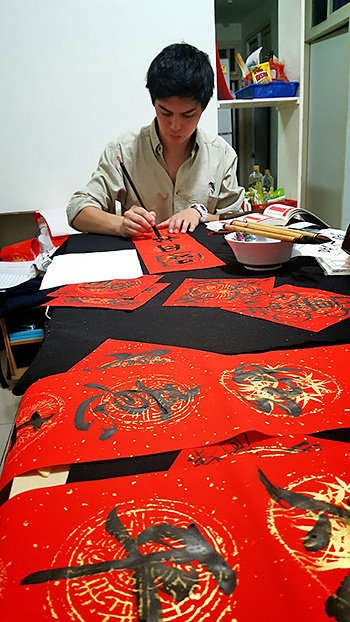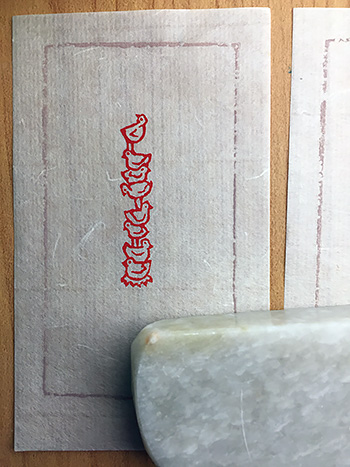
Vincent Chong '14, second from left, with his classmates and teachers in Taipei, Taiwan. Photo: provided.
Alum spends time in Taiwan immersed in art, language
As the first-born child in a Chinese-American family, Vincent Chong '14 has memories of receiving lots of small gold gifts as a young child – monkey pendant necklaces, "all kinds of little red containers," he says.

Chong practices calligraphy in Taiwan. The red paper is to celebrate the Chinese New Year. Photo: provided.
He thinks these memories have a lot to do with his current interest in small objects and intricate design, which he's pursuing after winning a scholarship to study in Taipei, Taiwan.
Chong, who majored in fine arts and mathematics, taught English in Taipei for a year after graduation, but now is studying calligraphy and Chinese and working on seal carving.
In Chinese culture, many people have custom-carved seals, which are commonly square and read "the seal of so and so," but they also can include intricate pictures and symbols. Seals are ubiquitous in Taiwan, where everyone uses them as a signature, at the bank, on a lease and to sign any important paper, Chong says. Most of these are laser-etched on wood. Other people own delicate stone seals, the kind Chong creates, which might include pictures or auspicious sayings and which are used to sign or stamp calligraphy works and paintings. Collectors also use them to mark their painting or book collections.
"Carving images is where my strength lies," says Chong, who carves all his seals on stone. Falling in love with the art, Chong entered a few seal-carving competitions. He won second place in the first competition he entered for foreigners and his teacher has told him that his ideas are unique.
Chong sees many similarities between seal-carving and the printmaking he did at Cornell.
"You're really looking and staring so hard as you watch something change in front of your eyes," he describes. "And there's this mystery of what's going to happen when you flip your print or seal over."

An image (the chickens signify the Year of the Chicken) made by one of the stone seal carvings Chong created. Photo: provided.
His calligraphy studies involve serious attention to detail. He is the youngest in his Taipei class, which includes a group of "aunties," dedicated disciples of his teacher who have studied calligraphy for 20 years or more.
"He makes me write the characters first and then we talk about how to make them better," Chong says. "I have some hideous first efforts."
To master the characters, Chong writes each one over and over, 12 times each on paper, while consulting his calligraphy reference volume of 1,000 characters. "When you get to the end, you start from the beginning again," he says.
The Chinese language classes he took at Cornell, especially the Intensive Mandarin Program, have prepared him well for his time in Taiwan, Chong says, but now that he's hearing the language consistently and trying to read Chinese signs, he's finally mastering finer points – like recognizing the subtle relationships between parts of characters and the sounds and meanings to which they refer.
"Cornell's program taught me to write in traditional characters (which are more complex), as well as simplified characters, and I understood the language and tones from my years of study," he says. "But nothing prepares you as well as going and being immersed in a Chinese-language environment."
Chong will be in Taipei until May, when he'll return to the United States for an internship at a gallery and before seeking a position in New York City as a printmaker.